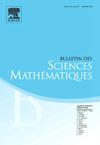On near orthogonality of the Banach frames for the wave packet spaces
IF 0.9
3区 数学
Q2 MATHEMATICS, APPLIED
引用次数: 0
Abstract
In solving scientific, engineering or pure mathematical problems one is frequently faced with a need to approximate the function of a given class with a specified precision by the linear combination of a preferably small number of simpler functions. This can often achieved by choosing the simpler functions localised one way or another both in the time and frequency domain. Constructing a set of linearly independent functions, let alone a basis, with a given time-frequency localisation is a formidable and often unsolvable problem, though. A much better chance one stands in building a set of time-frequency localised functions that constitutes a so-called frame – a generalisation of the notion of the basis, whose elements need not be linear independent, rather than a basis.
Over the last seventy years or so, a range of frames have been designed to allow the decomposition and synthesis of functions of various classes. The most prominent examples of such systems are Gabor functions, wavelets, ridgelets, curvelets, shearlets and wave atoms. We recently introduced a family of quasi-Banach spaces – which we called – that encompasses all those classes of functions whose elements have sparse expansions in one of the above-mentioned frames, supplied them with Banach frames – the kind of frames that ensure that any element of the class of functions for which a frame was designed can be decomposed and reconstructed using that frame – and provided their atomic decomposition. Herein we prove that the Banach frames for and sets of atoms of the wave packet spaces – which we call – are indeed localised in the time and frequency domain or, more specifically, that they are near orthogonal; and therefore so are all of the above-mentioned examples of frames.
We shall also show that, unlike those examples, the wave packet system can be made to assume a wide range of types and degrees of time-frequency localisation by the suitable choice of values of the parameters of the system. This, we believe, makes the wave packet systems not only suitable for decomposing, synthesising or approximating functions of a wide range of quasi-Banach function spaces in an efficient and effective way, but also for their use for representing linear bounded operators on the quasi-Banach spaces by sparse and well structured matrices using the Galerkin method. This, in its turn, should allow one to design efficient computer programs for solving corresponding operator equations on two-dimensional manifolds using finite element methods.
波包空间Banach帧的近正交性
在解决科学、工程或纯数学问题时,人们经常需要通过最好是少量较简单函数的线性组合来近似指定精度的给定类函数。这通常可以通过选择在时域和频域以某种方式局部化的较简单函数来实现。不过,要构建一组线性独立的函数,更不用说一个具有给定时频定位的基础了,这是一个艰巨的问题,而且往往无法解决。过去七十多年来,人们设计了一系列框架来分解和合成各类函数。过去七十多年来,人们设计了一系列框架来分解和合成各类函数,其中最突出的例子是 Gabor 函数、小波、脊小波、曲线小波、剪切小波和波原子。我们最近引入了一个准巴拿赫空间族--我们称之为波包空间--它包含了所有那些其元素在上述框架中具有稀疏展开的函数类,并为它们提供了巴拿赫框架--这种框架能确保为其设计框架的函数类中的任何元素都能用该框架进行分解和重构--并提供了它们的原子分解。在这里,我们将证明,波包空间的巴拿赫框架和原子集合--我们称之为波包系统--确实在时域和频域上是局部的,或者更具体地说,它们是近乎正交的;因此,上述所有框架的例子也是如此。我们还将证明,与这些例子不同,通过适当选择波包系统的参数值,可以使波包系统具有广泛的时频局部化类型和程度。我们认为,这使得波包系统不仅适用于以高效和有效的方式分解、合成或近似各种准巴纳赫函数空间的函数,还适用于使用伽勒金方法,通过稀疏和结构良好的矩阵来表示准巴纳赫空间上的线性有界算子。这反过来又能让人们设计出高效的计算机程序,利用有限元方法求解二维流形上的相应算子方程。
本文章由计算机程序翻译,如有差异,请以英文原文为准。
求助全文
约1分钟内获得全文
求助全文
来源期刊
CiteScore
1.90
自引率
7.70%
发文量
71
审稿时长
6-12 weeks
期刊介绍:
Founded in 1870, by Gaston Darboux, the Bulletin publishes original articles covering all branches of pure mathematics.

 求助内容:
求助内容: 应助结果提醒方式:
应助结果提醒方式:


